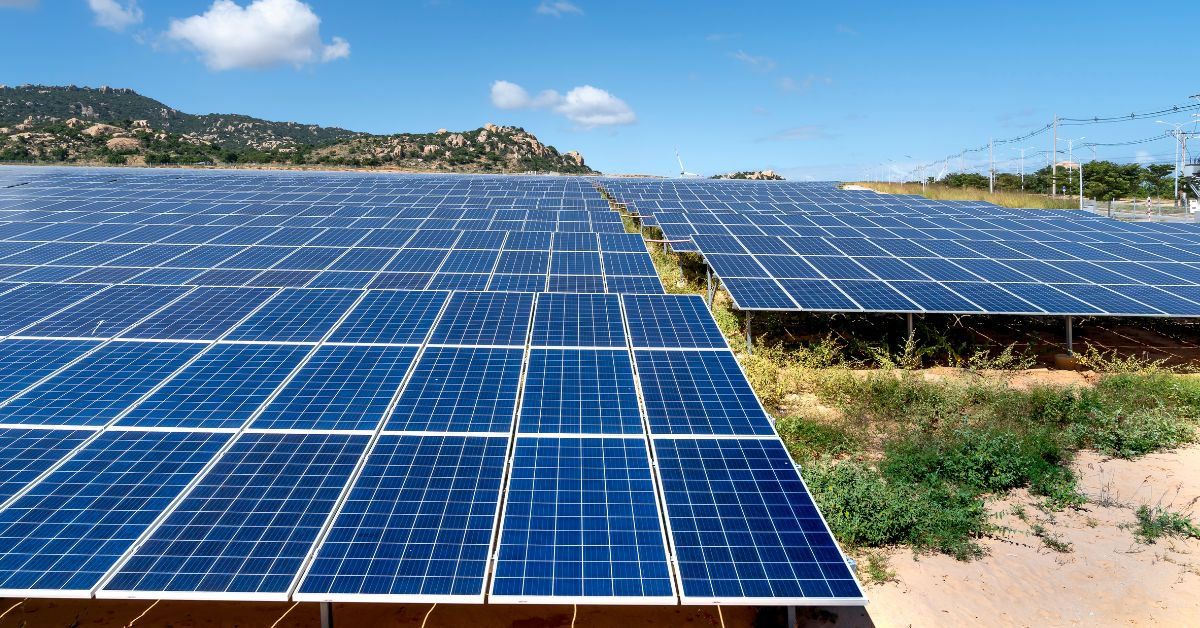Environmental Benefits of Solar Panels
Environmental Benefits of Solar Panels by harnessing clean, renewable energy from the sun. They significantly reduce greenhouse gas emissions, helping to combat climate change by displacing energy generated from fossil fuels.
Solar power also reduces air and water pollution, often linked to coal, oil, and natural gas energy production. Additionally, solar panels contribute to water conservation, as they require minimal water for maintenance compared to traditional energy sources like thermal power plants. By reducing dependency on finite resources, solar energy promotes sustainability, while contributing to healthier ecosystems and supporting a greener, more resilient future.
Environmental Benefits of Solar Panels
Table of Contents:
- Introduction
- Overview of Solar Energy
- Key Environmental Benefits of Solar Panels
- Reduction in Greenhouse Gas Emissions
- Decrease in Air Pollution
- Water Conservation
- Reduction of Dependence on Non-Renewable Energy Sources
- Solar Panels and Land Use
- Land Requirements for Solar Farms
- Innovations in Land Use: Rooftop Solar and Solar Integration
- Recycling and Waste Management in Solar Panel Production
- Solar Panel Lifespan and Durability
- Innovations Enhancing The Environmental Impact of Solar Technology
- Improvements in Solar Efficiency
- Solar Batteries and Energy Storage
- Perovskite Solar Cells
- Future Outlook and Challenges for Solar Panel Adoption
- Economic Barriers 8.2 Policy and Regulation Challenges
- Waste and Recycling Concerns
- FAQs About Environmental Benefits of Solar Panels
- Conclusion
Introduction
Solar energy is becoming an increasingly vital component of global efforts to reduce reliance on fossil fuels and combat climate change. The installation and use of solar panels represent one of the most significant technological advancements aimed at harnessing renewable energy sources. This blog will explore the key environmental benefits of solar panels, shedding light on how they contribute to a sustainable future.
Overview of Solar Energy
Solar energy is the radiant energy emitted by the sun, which can be converted into electricity using photovoltaic (PV) cells. The adoption of solar energy has grown exponentially due to its renewable nature, low maintenance costs, and potential to reduce greenhouse gas emissions significantly. Solar panels work by absorbing sunlight and converting it into electricity, with little to no pollution during operation. This sustainable energy production method contrasts sharply with traditional fossil fuel energy sources, which contribute heavily to climate change through carbon emissions.

Key Environmental Benefits of Solar Panels
Reduction in Greenhouse Gas Emissions
One of the most significant of the environmental advantages of solar panels is their ability to reduce greenhouse gas emissions. Fossil fuel power plants emit large quantities of carbon dioxide (CO2), methane (CH4), and other gases that contribute to global warming and climate change. By replacing energy generated from fossil fuels with solar energy, we can drastically reduce our carbon footprint.
According to the International Renewable Energy Agency (IRENA), solar energy could reduce global CO2 emissions by up to 4.9 gigatons annually by 2050. This reduction is critical to meeting global targets for mitigating the adverse effects of climate change, such as rising sea levels, extreme weather events, and ecosystem disruption.
Decrease in Air Pollution
Fossil fuel combustion releases harmful pollutants such as sulfur dioxide (SO2), nitrogen oxides (NOx), and particulate matter into the air, which can lead to smog formation, acid rain, and respiratory health problems. Solar energy generation does not emit these pollutants, contributing to cleaner air and a reduction in the incidence of respiratory illnesses, such as asthma and bronchitis.
A study by the National Renewable Energy Laboratory (NREL) in the U.S. estimated that by increasing the amount of solar energy in the energy mix, the U.S. could avoid up to 25,000 premature deaths per year caused by air pollution-related health issues.
Water Conservation
Conventional electricity generation, particularly from coal, natural gas, and nuclear power plants, requires vast amounts of water for cooling. Solar panels, on the other hand, require little to no water to generate electricity. This water-saving advantage is particularly crucial in regions where water scarcity is a growing concern due to climate change and overuse.
The Union of Concerned Scientists estimates that transitioning to renewable energy sources like solar can reduce water withdrawals by up to 90% compared to traditional fossil fuel plants. Water savings from solar energy help protect freshwater ecosystems and reduce competition for water resources between agriculture, industry, and households.
Reduction of Dependence on Non-Renewable Energy Sources
Solar energy represents a significant opportunity to reduce dependence on non-renewable energy sources such as coal, oil, and natural gas. These fossil fuels are finite, and their extraction and use cause significant environmental degradation, including habitat destruction, oil spills, and methane leaks. As solar technology continues to advance, it will become an even more viable alternative, helping society transition toward a clean energy economy.
By tapping into the unlimited power of the sun, solar panels reduce the need for resource extraction, transportation, and refining processes associated with fossil fuels, all of which have detrimental environmental impacts.
Solar Panels and Land Use
Land Requirements for Solar Farms
One of the common criticisms of solar energy is the amount of land required for large-scale solar farms. Solar farms, which are arrays of solar panels that produce large amounts of electricity, require significant space. However, when compared to fossil fuel extraction (such as coal mining or oil drilling), the land use impact of solar farms is minimal. Additionally, solar farms can be built in areas with limited agricultural value, such as deserts or former industrial sites.

Innovations such as floating solar farms on reservoirs and lakes (known as “photovoltaics”) have also emerged as ways to reduce the land impact of solar energy.
Innovations in Land Use: Rooftop Solar and Solar Integration
The use of solar panels on rooftops, parking structures, and even as building materials (building-integrated photovoltaics) allows for energy generation without additional land use. Rooftop solar systems are particularly beneficial in urban areas where land is limited but energy demand is high. These systems help offset electricity use, reduce utility costs, and alleviate the need for more large-scale power plants.
In agricultural settings, solar panels can be integrated into farms as “agrivoltaics,” where crops are grown under or around solar panels, allowing farmers to maintain food production while generating clean energy.
Recycling and Waste Management in Solar Panel Production
Although solar energy itself is clean, the production, disposal, and recycling of solar panels present some environmental challenges. Solar panels are made from materials such as silicon, glass, and metals, which require energy to produce and transport. At the end of their life cycle, solar panels need to be recycled or disposed of properly to avoid environmental harm.
Fortunately, the solar industry is working to develop efficient recycling programs. Europe has implemented regulations requiring solar panel manufacturers to take responsibility for recycling their products, and similar efforts are underway in other parts of the world. Research is also being conducted to improve the recyclability of solar panel materials, such as developing methods to recover valuable components like silicon and silver.
Solar Panel Lifespan and Durability
Solar panels are incredibly durable, with most having a lifespan of 25 to 30 years. During this time, they can consistently generate electricity with minimal maintenance. This longevity significantly reduces the environmental impact compared to fossil fuel power plants, which require constant fuel extraction and combustion.
While solar panels do degrade slightly over time, technological advancements have improved their efficiency and lifespan. This durability is an essential factor in the overall environmental benefit of solar energy, as it means fewer resources are needed for panel replacement and fewer environmental impacts from manufacturing and transportation.
Innovations Enhancing The Environmental Impact of Solar Technology
Improvements in Solar Efficiency
One of the main goals of solar panel research is to improve efficiency, which refers to the percentage of sunlight converted into electricity. Higher efficiency means that less land and fewer materials are required to generate the same amount of power, reducing the environmental footprint of solar energy.
Recent advancements in solar cell materials and designs, such as bifacial solar panels that capture sunlight on both sides, have significantly improved efficiency. These innovations are helping solar energy become even more sustainable.
Solar Batteries and Energy Storage
Energy storage is a critical component of maximizing the environmental benefits of solar energy. Solar batteries store excess energy generated during the day for use at night or during periods of low sunlight. This reduces the need for backup power from fossil fuel sources, making solar energy more reliable and consistent.
Lithium-ion batteries are currently the most common form of energy storage for solar systems, but new technologies like solid-state batteries and flow batteries are emerging as more environmentally friendly options with higher storage capacity and longer lifespans.
Perovskite Solar Cells
Perovskite solar cells are a promising new technology that could revolutionize solar energy. These cells are made from a unique material that is cheaper and more flexible than traditional silicon-based solar cells. Perovskite solar cells have the potential to reach higher efficiency levels and be produced with lower environmental costs, making them a game-changer in the field of renewable energy.
While perovskite solar cells are still in the research phase, their potential to reduce the cost and environmental impact of solar energy is significant. If widely adopted, they could make solar energy more accessible and environmentally friendly.
Future Outlook and Challenges for Solar Panel Adoption
Economic Barriers
Although the cost of solar panels has decreased dramatically in recent years, upfront installation costs remain a barrier for many individuals and businesses. While long-term savings are substantial, the initial investment can be prohibitive without government incentives, tax breaks, or financing options.
Widespread adoption of solar energy will require continued financial support from governments and institutions to make solar technology accessible to all.

Policy and Regulation Challenges
Government policies and regulations play a crucial role in promoting or hindering solar panel adoption. In some regions, regulatory hurdles such as permitting processes and grid connection issues slow down the deployment of solar projects. Additionally, fossil fuel subsidies in some countries create an uneven playing field, making it difficult for renewable energy technologies like solar to compete.
Policies that encourage investment in renewable energy infrastructure, streamline permitting processes, and phase out fossil fuel subsidies are essential for maximizing the environmental benefits of solar panels.
Waste and Recycling Concerns
As the use of solar panels continues to grow, waste management will become an increasingly important issue. Solar panels eventually reach the end of their life cycle, and without proper recycling programs, they could contribute to environmental degradation. The solar industry must invest in efficient recycling technologies and infrastructure to ensure that solar panels do not end up in landfills or create new environmental problems.
Innovative approaches to recycling, such as recovering valuable materials from old solar panels and designing panels with longer lifespans and recyclability in mind, will help mitigate this challenge.
FAQs About Environmental Benefits of Solar Panels
1. How do solar panels reduce greenhouse gas emissions?
Solar panels generate electricity without emitting carbon dioxide or other harmful greenhouse gases, unlike fossil fuels like coal or natural gas. Over their lifetime, solar panels can significantly reduce overall carbon emissions.
2. What impact does solar energy have on air quality?
By replacing fossil fuel-based power plants, solar energy reduces pollutants like sulfur dioxide, nitrogen oxides, and particulate matter, improving air quality and reducing respiratory and cardiovascular health issues.
3. How does solar power help conserve water resources?
Traditional power plants require vast amounts of water for cooling, while solar panels need minimal water for maintenance. This helps conserve water in areas prone to drought or with limited freshwater resources.
4. Can solar panels help reduce reliance on non-renewable energy sources?
Yes, solar energy is renewable and abundant. Increasing the use of solar panels helps decrease dependence on finite and polluting non-renewable resources like coal, oil, and natural gas.
5. Do solar panels produce any harmful emissions during their operation?
No, solar panels do not emit any harmful gases or pollutants during operation. The only emissions associated with solar panels come from manufacturing, transport, and installation, but these are far outweighed by the clean energy they generate over their lifetime.
6. What is the carbon footprint of manufacturing solar panels?
While manufacturing solar panels requires energy, much of which comes from fossil fuels, this initial carbon footprint is offset within 1-3 years of operation, depending on location. After that, they continue producing emission-free electricity for decades.
7. Do solar panels contribute to the preservation of ecosystems?
By reducing the need for land-intensive mining and drilling for fossil fuels, solar panels contribute to the preservation of ecosystems, biodiversity, and wildlife habitats, particularly in sensitive regions.
8. Can solar energy help combat climate change?
Yes, solar energy plays a critical role in reducing carbon emissions, which are the main driver of climate change. Transitioning to solar power helps slow global warming and mitigate its impacts, such as rising sea levels and extreme weather events.
9. How does solar energy reduce dependence on harmful energy extraction practices?
Solar energy decreases the need for environmentally harmful practices like coal mining, fracking, and oil drilling, which often cause habitat destruction, water contamination, and soil degradation.
10. Are solar panels recyclable, and how does this impact their environmental footprint?
Most solar panel components, such as glass, aluminum, and certain metals, can be recycled. As solar panel recycling technology advances, it further reduces solar panels’ long-term environmental footprint, making them an even more sustainable energy solution.
Conclusion
Solar panels offer a wide array of environmental benefits, from reducing greenhouse gas emissions and air pollution to conserving water and decreasing our reliance on finite, non-renewable energy sources. As technology advances and solar efficiency improves, the environmental impact of solar energy will continue to decrease, making it an increasingly important part of the global shift toward sustainability. Despite challenges such as land use, recycling, and policy barriers, solar panels remain one of the most promising tools in the fight against climate change and environmental degradation.
By investing in solar energy and supporting policies that encourage renewable energy adoption, we can pave the way for a cleaner, more sustainable future.
Click Here to learn more about Environmental Benefits of Solar Panels

